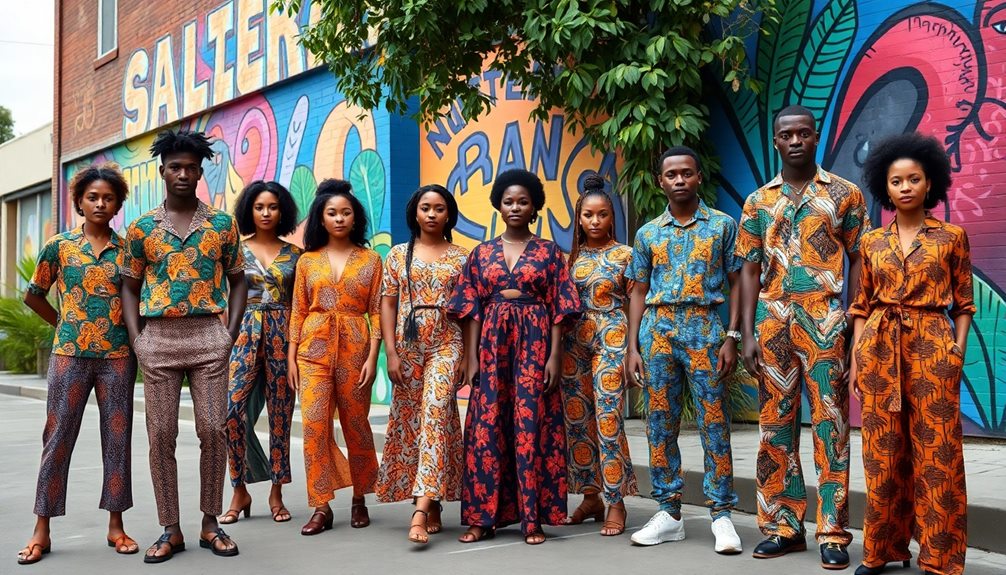African print fashion is undergoing a vibrant transformation that blends traditional elements with contemporary styles. As you explore these modern interpretations, you'll see how designers reinterpret cultural motifs and colors to connect with a global audience. Each fabric tells a story, showcasing values and heritage while standing out on runways and in everyday wear. Brands increasingly focus on sustainable practices, emphasizing ethical production and local materials. The burgeoning market reflects the growing appreciation for Afrocentric designs. Keep exploring to uncover how this fashion revolution is shaping both the industry and cultural narratives worldwide.
Key Takeaways
- African prints, rooted in 19th-century batik techniques, symbolize cultural pride and convey community values through unique patterns and colors.
- Contemporary designers reinterpret traditional motifs, enhancing cultural connections and increasing the global visibility of African fashion.
- Collaborations between African artisans and international brands promote sustainable practices, emphasizing ethical production and local materials in fashion.
- The projected growth of the African fashion market highlights its rising significance, with a focus on preserving cultural narratives through modern designs.
- Challenges such as limited retail presence and negative perceptions call for initiatives that support African fashion education and supply chain transparency.
Historical Context of African Prints
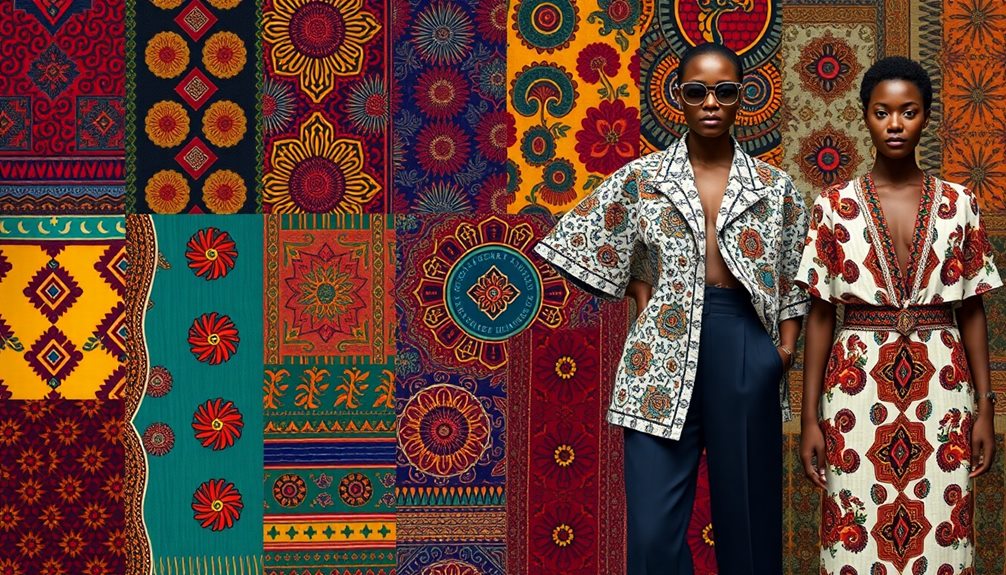
Emerging from the vibrant tapestry of African culture, African print fabrics have a rich historical context that dates back to the 19th century. Originally influenced by Indonesian batik techniques, these fabrics were introduced to West Africa by Dutch traders, marking a transformative moment in textile production. The adoption of wax-resist dyeing methods led to the creation of vibrant fabrics tailored to local tastes, sparking a demand that revolutionized the textile industry.
While traditional textiles like kente cloth and mud cloth predate African prints, they also carry deep cultural significance. These textiles convey stories and social status through specific patterns and colors, enriching the fabric of African identity.
As African artisans began collaborating with European manufacturers, they infused traditional symbols and motifs into fabric designs, resulting in culturally relevant patterns that resonate with the community.
This evolution of African prints has paved the way for modern interpretations in global fashion. Contemporary designers now blend traditional aesthetics with innovative styles, enhancing the appeal of these vibrant fabrics on an international scale.
Understanding this historical context deepens your appreciation for the artistry and cultural heritage behind African print fashion.
Cultural Significance of Patterns
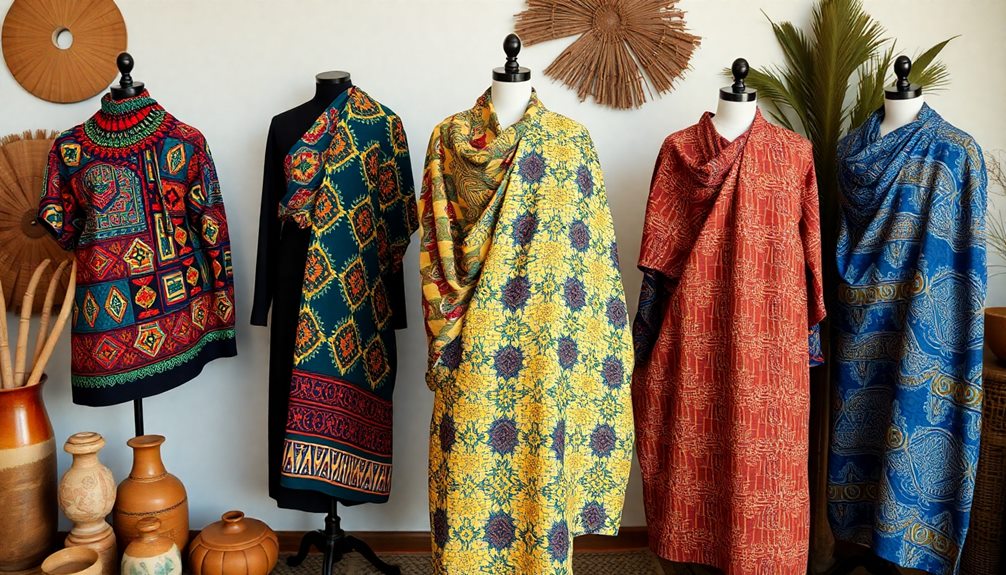
When you explore African print fabrics, you'll notice that each pattern tells a story, rich with cultural significance.
These designs aren't just for show; they symbolize social status, beliefs, and community identity.
Understanding this symbolism opens up a deeper appreciation for the artistry woven into every piece.
Pattern Storytelling Importance
Patterns in African print fabrics are more than just visual elements; they're vibrant storytellers that convey deep-rooted cultural narratives. Each intricate pattern reflects the values, beliefs, and social status of the communities they represent. By wearing these textiles, you embrace a rich cultural heritage that connects you to the past while celebrating modern fashion.
Consider the emotions stirred by these stories:
- The pride in showcasing traditional symbols that honor your ancestry.
- The joy of wearing designs that reflect community values and history.
- The warmth of connecting with agricultural motifs that celebrate local resources.
- The unity expressed through geometric shapes representing harmony and stability.
This pattern storytelling serves as a reminder of the importance of preserving cultural heritage. Historical textiles like Kente cloth communicate proverbs and significant events, enriching the narrative behind each fabric.
Even as local artisans adapt these patterns in collaboration with European manufacturers, they maintain the essence of their cultural significance. By choosing African Print, you're not just wearing a fabric; you're weaving a story filled with meaning and connection to a vibrant legacy.
Symbolism in Fabric Design
African print fabrics are a vibrant tapestry of symbols that carry profound cultural significance. When you wear these unique patterns, you're not just showcasing vibrant colors; you're expressing cultural pride and a deep connection to your heritage. The designs often incorporate traditional symbols that convey messages about community values, social status, and important life events, like marriage or mourning.
Take Kente cloth, for example. Each geometric shape and motif tells a story, reflecting ideals such as unity, stability, and strength, which are central to many African cultures. The patterns may represent specific proverbs or historical events, enriching the fabric's meaning.
Moreover, local artisans adapt foreign prints, creating designs that highlight agricultural and natural elements, like corn and cocoa, reinforcing the bond between culture and environment.
The colors used in these fabrics are equally intentional; red signifies life force, green symbolizes growth, and yellow indicates prosperity. Each hue plays a significant role in cultural ceremonies and fashion choices, ensuring that every piece of African print fabric tells a story that honors tradition while celebrating modern interpretations.
The Role of Color in Fabrics
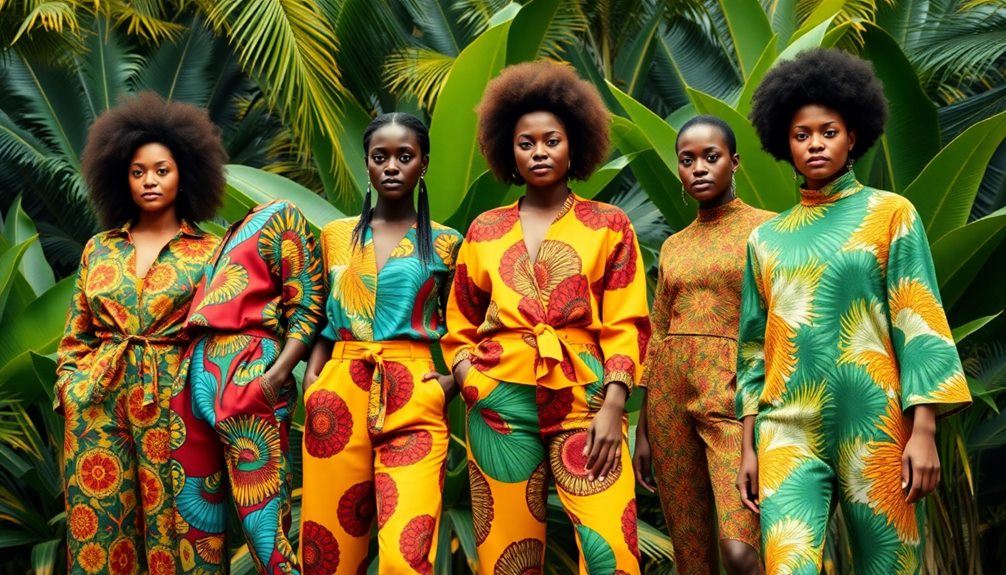
When you explore African Print Fabrics, you'll notice how colors convey powerful cultural symbolism and emotional resonance.
Each hue not only reflects community values but also influences your perception of social status and identity.
Understanding these connections can deepen your appreciation for the intricate patterns and meanings woven into each piece. Understanding these connections can deepen your appreciation for the intricate patterns and meanings woven into each piece. This perspective is particularly valuable when exploring how artistry intersects with functional living, such as in maximizing small spaces design. By blending aesthetics with purposeful layouts, even the most compact areas can become visually striking and highly efficient.
Cultural Color Symbolism
In the vibrant world of African print fabrics, colors play a crucial role in conveying deep cultural meanings. Each hue carries significance that reflects identity, heritage, and traditional practices. For instance, red symbolizes life force, green represents growth, and yellow signifies prosperity. These colors often appear in ceremonies, bringing communities together and offering protection.
- Colors serve as a visual language, expressing beliefs and social connections.
- Specific patterns can indicate social status or tribal affiliation.
- Adinkra symbols enrich narratives, adding layers of meaning to each design.
- Contemporary designers bridge the past and present, incorporating traditional color symbolism into modern fashion.
The choice of colors in fabrics transcends mere aesthetics; it tells stories of lineage, authority, and community identity. By wearing these vibrant prints, you embrace a rich cultural tapestry, celebrating the symbolism and significance embedded in each thread.
As you explore African print fashion, consider how these colors connect you to your roots and reflect the pride of a shared heritage. Embracing this cultural color symbolism allows you to wear your identity with confidence and purpose.
Emotional Impact of Colors
Colors in African print fabrics do more than just tell stories; they evoke powerful emotions that resonate within individuals and communities. The vibrant colors you see in these fabrics carry profound cultural meanings. For instance, red symbolizes life force, green represents growth, and yellow signifies prosperity. Each of these colors influences emotional responses and societal perceptions, enhancing your connection to your heritage.
When you wear African print, the color choices reflect your personal identity and community belonging. The patterns often utilize specific color combinations that denote social status, age, or tribal affiliation, reinforcing your ties to your roots.
Additionally, Adinkra symbols, intricately woven into the designs, use colors to convey complex ideas and stories, enriching the emotional narrative behind the fabrics.
The psychological impact of these vibrant colors can evoke feelings of unity and protection, especially during ceremonies. They serve as a reminder of shared cultural values, reinforcing community bonds through common color symbolism.
Patterns and Color Meanings
Explore the intricate relationship between patterns and colors in African print fabrics, where every design tells a story. The vibrant hues and unique patterns you see aren't just for aesthetics; they carry profound cultural significance. Each color has its own meaning—red symbolizes life force, green represents growth, and yellow signifies prosperity. These colors often appear in ceremonial contexts, expressing unity and protection.
Additionally, patterns reveal social status, age, or tribal affiliation, making them a visual language that connects wearers to their heritage. Adinkra symbols like Sankofa and Gye Nyame enrich these narratives, reinforcing values and beliefs inherent in various cultures.
- Feel the life force of red, pulsing with energy.
- Embrace the growth symbolized by green, inviting new beginnings.
- Celebrate prosperity through the warmth of yellow.
- Connect with your roots through intricate patterns.
In contemporary adaptations of African Print Fabrics, you witness a beautiful blend of traditional symbols and modern aesthetics. This fusion allows you to connect with African heritage while engaging with current fashion trends, making these fabrics not just clothing, but a powerful expression of identity.
Modern Designers and Innovations
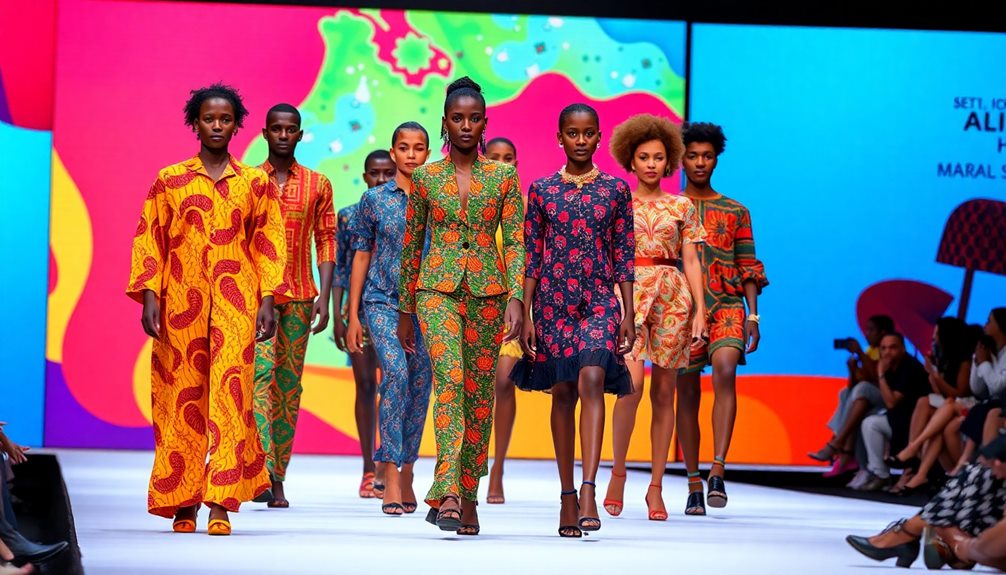
Modern African print fashion is thriving, thanks to a wave of innovative designers who reinterpret traditional patterns for today's audience. These modern designers blend bold patterns and vibrant colors with contemporary fashion silhouettes, creating garments that resonate with both local and global consumers.
Brands like Vlisco are at the forefront, collaborating with African artisans to develop culturally significant designs that preserve traditional motifs while appealing to modern tastes.
The rise of Afrocentric fashion has increased visibility for African designers on international runways, breaking barriers and challenging outdated stereotypes. Innovations in sustainable production methods and ethical sourcing are also gaining traction, addressing environmental concerns and promoting responsible fashion practices.
By embracing these innovations, designers demonstrate a commitment to the planet while staying true to their cultural roots.
Moreover, the power of digital platforms and e-commerce allows these designers to reach broader markets, elevating the cultural significance of African print fabrics worldwide. This newfound accessibility not only showcases the richness of African heritage but also fosters a global appreciation for the artistry behind each piece.
As you explore these modern interpretations, you'll see how African print fashion is indeed a vibrant expression of identity and creativity.
Global Impact of African Fashion

African fashion has made a significant global impact, with countless designers showcasing their work on prestigious platforms. The popularity of African Print fabrics has skyrocketed, thanks to talented African designers like Thebe Magugu and Kenneth Ize. They're not just creating stunning pieces; they're telling rich cultural narratives that resonate worldwide.
- Feel the vibrant colors and intricate patterns that celebrate heritage.
- Experience the cultural fusion that breathes new life into modern interpretations.
- Witness the powerful stories woven into every garment.
- Support local artisans and communities as they gain recognition and opportunities.
Online platforms and social media have played essential roles in elevating African fashion's visibility, connecting designers with global audiences. Collaborations between African designers and international brands are becoming more common, further integrating these unique prints into mainstream fashion.
With sales of African-inspired fashion surging, the industry not only thrives economically but also promotes sustainable practices and cultural preservation. This global impact of African fashion is a celebration of creativity and connection, inviting you to embrace and support this vibrant movement.
Sustainable Practices in Fashion
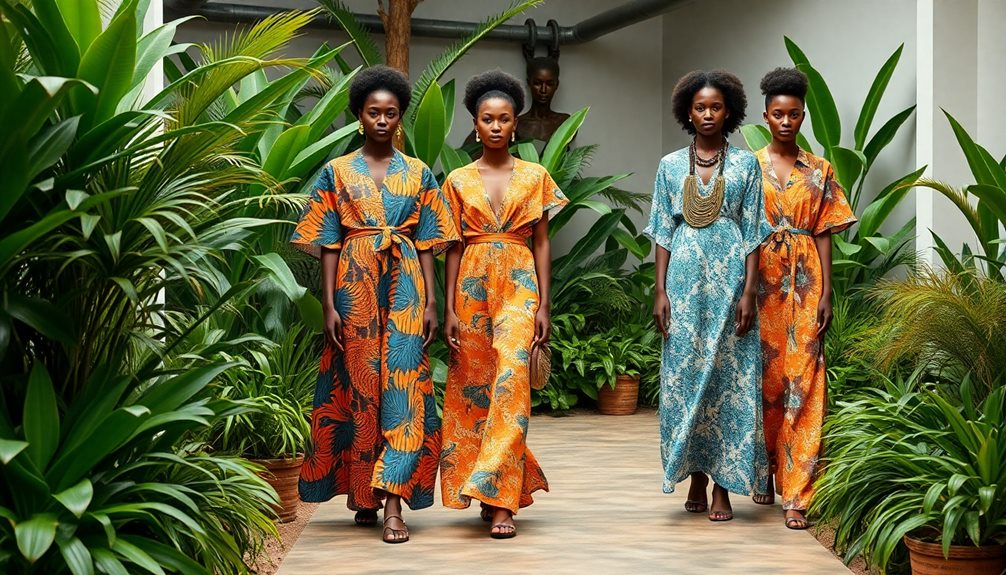
Embracing sustainability, the African fashion industry is taking significant strides towards eco-friendly practices that resonate with global movements. You'll find many designers prioritizing sustainable practices by using eco-friendly materials and ethical production methods. This shift not only minimizes environmental impact but also supports local economies.
By focusing on locally sourced, natural fibers and dyes, these designers promote a circular fashion model, which emphasizes reusing and recycling materials. Initiatives like Fashion Revolution Nigeria are pushing for transparency in the supply chain, urging brands to disclose their production processes and source materials sustainably.
Moreover, the emphasis on artisanal craftsmanship and traditional textile techniques sets African fashion apart from the fast fashion movement. This approach promotes longevity and quality in garments, ensuring that each piece tells a story and stands the test of time.
As awareness of sustainability grows, collaborations between African designers and global brands are also on the rise, fostering an exchange of ideas that benefits both the environment and local communities.
You'll see that these sustainable practices not only enhance the fashion landscape but also contribute to a more responsible and ethical industry.
Challenges Facing African Fashion
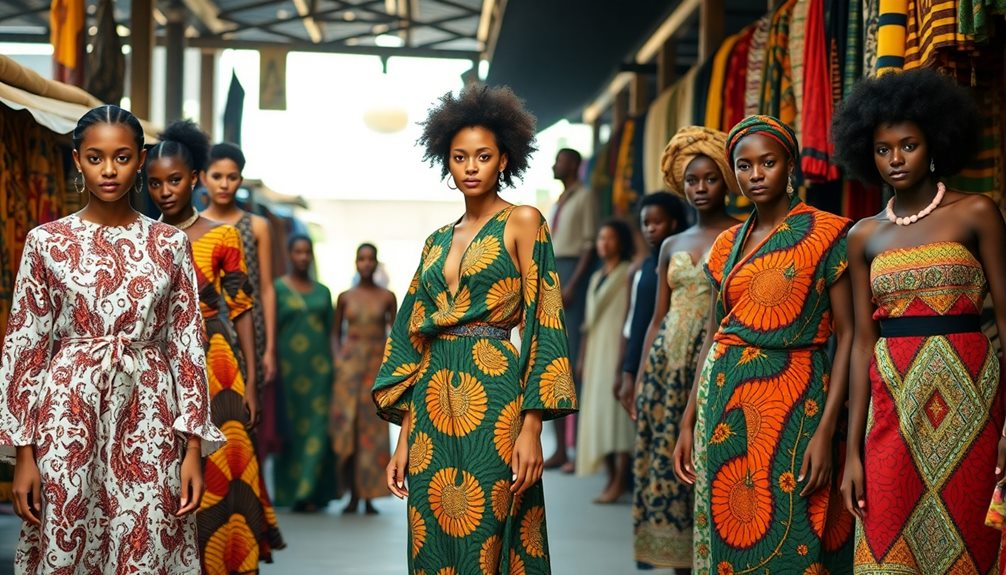
Steering through the complexities of the fashion landscape, designers face significant challenges that hinder the growth of African fashion on a global scale. One major barrier is the limited presence of African fashion in multi-brand retailers, often stemming from small-scale production hurdles. This makes it tough for designers to scale and access international markets.
Additionally, many emerging designers grapple with balancing local growth while aspiring for broader distribution, which can feel like an uphill battle.
- The negative perception of African products impacts pricing structures.
- Fashion education often neglects the rich contributions of African designers.
- Market access remains elusive, hindering potential success.
- There's a pressing need for resources to document African fashion accurately.
To make matters worse, the lack of education on African fashion perpetuates stereotypes, influencing how it's perceived both locally and globally.
Designers need support to navigate these challenges, and fostering a deeper understanding of African fashion is essential for a more equitable future. By addressing these issues, you can help pave the way for a thriving African fashion industry that truly reflects its vibrant heritage and potential.
Future Directions for African Style
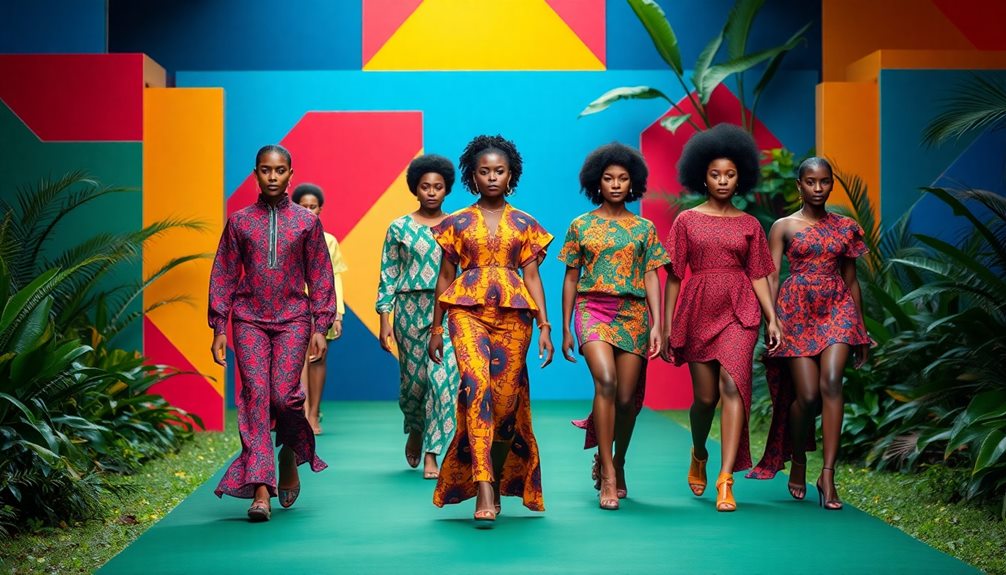
The future of style in Africa holds immense promise as the industry positions itself for growth and innovation. With an estimated market value projected to reach $15.5 billion by 2028, the global demand for African fashion and African-inspired prints is skyrocketing.
Emerging designers are embracing sustainable practices, focusing on reducing environmental impact through locally sourced materials and traditional craftsmanship.
You'll notice that collaborations between African designers and international brands are becoming more common, which fosters cultural exchange and broadens the reach of African fashion to diverse audiences. This exchange not only elevates the unique aesthetics of African styles but also strengthens their place in the global fashion scene.
Social media platforms play an essential role in this evolution. Influencers and bloggers amplify the visibility of Afrocentric designs, sharing cultural narratives that resonate with audiences worldwide.
Additionally, initiatives aimed at decolonizing fashion education are gaining traction, promoting a more inclusive understanding of African fashion history and contemporary practices.
As these trends continue to unfold, you can expect a vibrant future where African style not only thrives but also inspires and influences the global fashion landscape.
Frequently Asked Questions
How Can I Incorporate African Prints Into My Everyday Wardrobe?
You can easily incorporate African prints into your wardrobe by mixing bold patterned accessories, like scarves or bags, with neutral outfits. Try pairing a printed top with jeans, or even a statement dress for added flair.
Are There Specific Occasions Best Suited for African Print Clothing?
When it comes to specific occasions, you can't go wrong with vibrant African prints at celebrations, parties, or cultural events. They add flair and personality, making you stand out while embracing your unique style.
What Materials Are Commonly Used in African Print Fashion?
In African print fashion, you'll commonly find materials like cotton, silk, and polyester. Cotton's breathable quality makes it popular, while silk adds elegance. Polyester offers durability, ensuring your outfits last through various occasions and styles.
How Do I Care for African Print Garments to Maintain Their Quality?
Think of your favorite book; you wouldn't toss it in water. Similarly, hand wash your African print garments in cold water, avoid harsh detergents, and hang them to dry, preserving their vibrant stories for years.
Where Can I Purchase Authentic African Print Fashion Items Online?
You can purchase authentic African print fashion items online at reputable retailers like Etsy, Afrikrea, and local boutiques with online shops. Always check reviews to ascertain you're getting quality products that truly represent the culture.
Conclusion
As you explore the vibrant world of African print fashion, you'll see it's not just about fabric; it's a tapestry woven with history, culture, and innovation. Like a kaleidoscope, the styles shift and change, reflecting the creativity and resilience of modern designers. Embracing sustainable practices and overcoming challenges, African fashion is poised for a brilliant future. Immerse yourself in this revolution, and let the colors and patterns inspire your own unique style journey.
